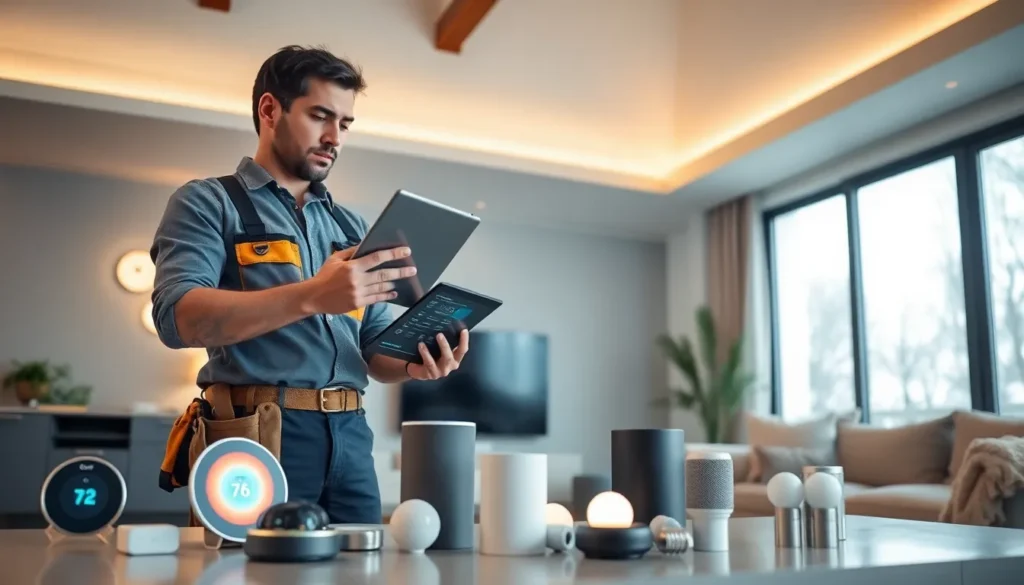Ever wished your home could understand you? Picture walking in after a long day, and your lights softly flicker on, your favorite playlist starts playing, and the thermostat adjusts to the perfect cozy setting, all without lifting a finger. This is the magic of smart home automation installation. Sounds futuristic, right? Well, it’s not. It’s not only possible, but it’s also easier than you think. Let’s jump into the world of smart homes, where technology meets convenience and brings a splash of fun into your everyday life.
Table of Contents
ToggleUnderstanding Smart Home Automation

Smart home automation refers to the seamless integration of devices and systems in a household, allowing them to communicate with each other and help tasks automatically. This means that an array of gadgets, like lights, locks, thermostats, cameras, and even kitchen appliances, can work together to enhance your living experience.
Imagine your coffee maker receiving a signal from your alarm clock to brew a fresh pot as soon as you wake up. That’s not a scene from a sci-fi movie: it’s the essence of smart home automation. With the right setup, homeowners can control these devices through mobile apps or voice commands, simplifying their lives and adding a sprinkle of sophistication. In today’s connected world, understanding this technology is the first step to transforming a regular home into an intuitive living space.
Benefits of Smart Home Automation
The advantages of smart home automation go far beyond just cool gadgets. Convenience tops the list: who wouldn’t want to control their entire home from their smartphone? Imagine adjusting your thermostat from work or turning on the lights without getting off the couch.
Energy efficiency is another significant plus. Smart systems can optimize energy use by learning your habits and automatically adjusting settings. Some devices even track energy consumption, letting homeowners monitor how much they spend on utilities.
Let’s not forget security. Smart locks, cameras, and alarm systems provide an enhanced level of protection, allowing homeowners to monitor their property remotely. Plus, automating your home can deter potential burglars who might think twice when they see lights flickering on and off seemingly at random.
Finally, there’s enhanced comfort. Smart home technologies can create an environment that caters to personal preferences, whether it’s adjusting the lighting for a movie night or setting the perfect temperature for a good night’s sleep. It’s all about making life a little easier, and a lot more enjoyable.
Planning Your Smart Home Setup
Setting up a smart home isn’t just about buying the latest gadgets: it involves careful planning to ensure everything works seamlessly together.
Choosing the Right Devices
With myriad options on the market, selecting the right devices can feel overwhelming. Start by identifying the main areas of your home that you’d like to automate. Consider devices that offer integration capabilities, meaning they can work together without constant manual intervention. Do some research on user reviews and compatibility with existing systems to make informed decisions.
Integration and Compatibility
Always check for compatibility with your current Wi-Fi systems and any existing devices. Some brands have closed ecosystems, while others offer wider compatibility across various platforms. This consideration can save you headaches down the road and ensure a smoother installation process.
Installation Process
Once devices are chosen, it’s time to install. This process can vary depending on whether you opt for DIY or professional help.
DIY vs. Professional Installation
For tech-savvy individuals, installing smart devices can be a fulfilling project. Many products come with detailed instructions and online tutorials. But, if you feel lost in the tech maze or just don’t have the time, hiring a professional might be the way to go. They can ensure everything is set up correctly and give you peace of mind.
Step-by-Step Installation Guide
- Plan Your Layout: Decide where each device will be placed.
- Download Necessary Apps: Most smart devices operate through specific apps, so download those beforehand.
- Connect to Wi-Fi: Follow the manufacturer’s instructions to connect each device to your home network.
- Test Each Device: After installation, ensure each device is functioning correctly before finalizing everything.
- Create Automations: Most smart home systems allow you to set routines or automations that can enhance functionality.
Troubleshooting Common Issues
Even the smartest devices can encounter hiccups. Some common issues include connectivity problems, malfunctioning devices, or compatibility errors.
- Connectivity Problems: Ensure your Wi-Fi signal is strong. Sometimes, devices are just too far from the router: using a Wi-Fi extender could solve the issue.
- Device Malfunctions: Devices may require occasional resets or firmware updates. Follow the manufacturer’s guidance for troubleshooting.
- Compatibility Errors: Check online forums or reach out to customer support for help if devices aren’t playing well together. Many manufacturers offer quick fixes or updates.
Maintaining Your Smart Home System
Keeping your smart home running smoothly requires regular maintenance. This includes updating firmware, checking batteries, and ensuring everything is operating correctly.
Schedule periodic checks of your devices to ensure they are still functioning as intended. Regular updates can introduce new features, improve security, and fix bugs.
Plus, keeping your networks secure is crucial to prevent unauthorized access. Regularly update passwords and leverage two-factor authentication where available to maintain optimal security.

